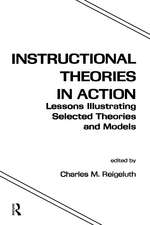Instruction Design for Microcomputing Software
Editat de David Jonassenen Limba Engleză Paperback – mar 1988
| Toate formatele și edițiile | Preț | Express |
|---|---|---|
| Paperback (1) | 789.54 lei 6-8 săpt. | |
| Taylor & Francis – mar 1988 | 789.54 lei 6-8 săpt. | |
| Hardback (1) | 1025.10 lei 6-8 săpt. | |
| Taylor & Francis – 21 aug 2017 | 1025.10 lei 6-8 săpt. |
Preț: 789.54 lei
Preț vechi: 962.85 lei
-18% Nou
Puncte Express: 1184
Preț estimativ în valută:
151.07€ • 158.30$ • 124.89£
151.07€ • 158.30$ • 124.89£
Carte tipărită la comandă
Livrare economică 11-25 aprilie
Preluare comenzi: 021 569.72.76
Specificații
ISBN-13: 9780805800869
ISBN-10: 0805800867
Pagini: 468
Dimensiuni: 152 x 229 x 24 mm
Greutate: 0.66 kg
Ediția:1
Editura: Taylor & Francis
Colecția Routledge
Locul publicării:Oxford, United Kingdom
ISBN-10: 0805800867
Pagini: 468
Dimensiuni: 152 x 229 x 24 mm
Greutate: 0.66 kg
Ediția:1
Editura: Taylor & Francis
Colecția Routledge
Locul publicării:Oxford, United Kingdom
Public țintă
ProfessionalRecenzii
"The book does an admirable job of presenting the current state of the art. It provides excellent coverage of the various instructional theories...."
—American Scientist
—American Scientist
Cuprins
Contents: Part I: Instructional Design and Courseware Design. Introduction. M.D. Roblyer, Fundamental Problems and Principles of Designing Effective Courseware. W. Wager, R.M. Gagn, Designing Computer-Aided Instruction. M.D. Merrill, Applying Component Display Theory to the Design of Courseware. Part II: Interactive Designs for Courseware. Introduction. toc D.A. Salisbury, Effective Drill and Practice Strategies. W.E. Montague, Promoting Cognitive Processing and Learning by Designing the Learning Environment. D.H. Jonassen, Integrating Learning Strategies into Courseware to Facilitate Deeper Processing. B.J. Schimmel, Providing Meaningful Feedback in Courseware. Part III: Adaptive Designs for Courseware. Introduction. A External Adaptations. C.A. Carrier, D.H. Jonassen, Adapting Courseware to Accommodate Individual Differences. S.M. Ross, G. Morrison, Adapting Instruction to Learner Performance and Background Variables. R.D. Tennyson, D.L. Christensen, MAIS: An Intelligent Adaptive Learning System. B Internal Adaptations. W. Hannum, Designing Courseware to Fit Subject Matter Structure. Part IV: :Toward Intelligent CAI on Microcomputers. Introduction. S.A. Dennenberg, Semantic Network Designs for Courseware. W.E. McKay, Tutoring, Information Databases, and Iterative Design. J.M. Scandura, The Intelligent Rule Tutor. G. Kearsley, Authoring Systems for Intelligent Tutoring Systems on Personal Computers. Part V: Designing Motivating Courseware. Introduction. J. Keller, K. Suzuki, Application of the ARCS Motivation Model in Courseware Design.
Descriere
Descriere de la o altă ediție sau format:
Museums display much more than artifacts; Museum Culture makes us on a tour through the complex of ideas, values and symbols that pervade and shape the practice of exhibiting today. Bringing together a broad range of perspectives from history, art history, critical theory and sociology, the contributors to this new collection argue that museums have become a central institution and metaphor in contemporary society.Discussing exhibition histories and practice in Western Europe, the former Soviet Union, Israel and the United States, the authors explore the ways in which museums assign meaning to art through various kinds of exhibitions and display strategies, examining the political implications of these strategies and the forms of knowledge they invoke and construct. The collection also discusses alternative exhibition forms, the involvement of some museums with the more spectacular practices of mass media culture, and looks at how museums construct their public.
Museums display much more than artifacts; Museum Culture makes us on a tour through the complex of ideas, values and symbols that pervade and shape the practice of exhibiting today. Bringing together a broad range of perspectives from history, art history, critical theory and sociology, the contributors to this new collection argue that museums have become a central institution and metaphor in contemporary society.Discussing exhibition histories and practice in Western Europe, the former Soviet Union, Israel and the United States, the authors explore the ways in which museums assign meaning to art through various kinds of exhibitions and display strategies, examining the political implications of these strategies and the forms of knowledge they invoke and construct. The collection also discusses alternative exhibition forms, the involvement of some museums with the more spectacular practices of mass media culture, and looks at how museums construct their public.
























